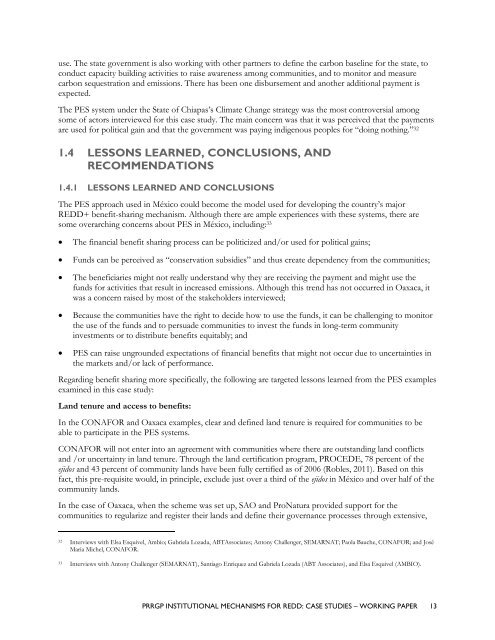Institutional Mechanisms for REDD+ - Case Studies Working Paper
Institutional Mechanisms for REDD+ - Case Studies Working Paper
Institutional Mechanisms for REDD+ - Case Studies Working Paper
Create successful ePaper yourself
Turn your PDF publications into a flip-book with our unique Google optimized e-Paper software.
use. The state government is also working with other partners to define the carbon baseline <strong>for</strong> the state, to<br />
conduct capacity building activities to raise awareness among communities, and to monitor and measure<br />
carbon sequestration and emissions. There has been one disbursement and another additional payment is<br />
expected.<br />
The PES system under the State of Chiapas‘s Climate Change strategy was the most controversial among<br />
some of actors interviewed <strong>for</strong> this case study. The main concern was that it was perceived that the payments<br />
are used <strong>for</strong> political gain and that the government was paying indigenous peoples <strong>for</strong> ―doing nothing.‖ 32<br />
1.4 LESSONS LEARNED, CONCLUSIONS, AND<br />
RECOMMENDATIONS<br />
1.4.1 LESSONS LEARNED AND CONCLUSIONS<br />
The PES approach used in México could become the model used <strong>for</strong> developing the country‘s major<br />
<strong>REDD+</strong> benefit-sharing mechanism. Although there are ample experiences with these systems, there are<br />
some overarching concerns about PES in México, including: 33<br />
� The financial benefit sharing process can be politicized and/or used <strong>for</strong> political gains;<br />
� Funds can be perceived as ―conservation subsidies‖ and thus create dependency from the communities;<br />
� The beneficiaries might not really understand why they are receiving the payment and might use the<br />
funds <strong>for</strong> activities that result in increased emissions. Although this trend has not occurred in Oaxaca, it<br />
was a concern raised by most of the stakeholders interviewed;<br />
� Because the communities have the right to decide how to use the funds, it can be challenging to monitor<br />
the use of the funds and to persuade communities to invest the funds in long-term community<br />
investments or to distribute benefits equitably; and<br />
� PES can raise ungrounded expectations of financial benefits that might not occur due to uncertainties in<br />
the markets and/or lack of per<strong>for</strong>mance.<br />
Regarding benefit sharing more specifically, the following are targeted lessons learned from the PES examples<br />
examined in this case study:<br />
Land tenure and access to benefits:<br />
In the CONAFOR and Oaxaca examples, clear and defined land tenure is required <strong>for</strong> communities to be<br />
able to participate in the PES systems.<br />
CONAFOR will not enter into an agreement with communities where there are outstanding land conflicts<br />
and /or uncertainty in land tenure. Through the land certification program, PROCEDE, 78 percent of the<br />
ejidos and 43 percent of community lands have been fully certified as of 2006 (Robles, 2011). Based on this<br />
fact, this pre-requisite would, in principle, exclude just over a third of the ejidos in México and over half of the<br />
community lands.<br />
In the case of Oaxaca, when the scheme was set up, SAO and ProNatura provided support <strong>for</strong> the<br />
communities to regularize and register their lands and define their governance processes through extensive,<br />
32 Interviews with Elsa Esquivel, Ambio; Gabriela Lozada, ABTAssociates; Antony Challenger, SEMARNAT; Paola Bauche, CONAFOR; and José<br />
Maria Michel, CONAFOR.<br />
33 Interviews with Antony Challenger (SEMARNAT), Santiago Enriquez and Gabriela Lozada (ABT Associates), and Elsa Esquivel (AMBIO).<br />
PRRGP INSTITUTIONAL MECHANISMS FOR REDD: CASE STUDIES – WORKING PAPER 13

















